Pasting of walls and ceilings with wallpaper is still the most popular and affordable option. But this material is already 4 thousand years old! But our people are not in a hurry to change it to more modern ways of finishing - mainly because of simple and unpretentious mounting technology. Indeed, what could be easier: he came to the building store, bought the rolls he liked, and stuck them on the walls. But the further fate of fresh repair depends on the right choice of wallpaper.

Contents:
- The best wallpaper manufacturers
- The types of wallpaper
- The choice of wallpaper
- What wallpapers to choose for different rooms
- How much are the wallpapers
The best wallpaper manufacturers - Which company to choose
Every year in the world millions of wallpaper rolls are striking, affecting a variety of patterns and textures. The products of the following companies are well-deservedly popular:
- Marburg Wallcoverings
- Eco
- Arthouse
- Casadeco
- Omexco
European brands specialize in the production of elite finishing materials on a thickened or fabric basis. Models can be found more easily in the lines of foreign brands having their own production facilities in our country( Rasch, Erismann).Also a good quality is offered by domestic factories, for example, Palitra or Beloboy.
But the name on the label is not the only thing that you will have to pay attention to when buying. You also have to study the features of existing finishing materials taking into account the conditions in which they will be used.
Types of wallpaper
Manufacturers do not stop experimenting with materials and their combinations in the manufacture of wallpaper. As a result, so many different tapestries appeared on the market, that the eyes scatter. All of them look beautiful, both in rolls and on walls, but their basic properties and service life can differ substantially.
Paper

Classics of the genre that it's too early to scrap. Modern cellulose products are very different from their predecessors of the Soviet era attractive design and juicy colors. When they are manufactured, toxic paints or harmful impurities are not used, therefore they are considered one of the most environmentally friendly.
On sale there are 3 types of paper wallpaper consisting of several layers of pressed paper:
1. simplex;
2. Duplex;
3. triplex.
Multilayer versions have greater strength and thickness, which allows you to hide under the canvases of small uneven walls. The fragility and impracticality of cellulose is more than covered by a very democratic price - you can make repairs without serious damage to the budget.
After pasting paper wallpapers in the nursery, you do not have to drink valerian, discovering on the wall another masterpiece with felt-tip pens or a bas-relief made of plasticine.
Pros:
- Affordable price;
- Huge assortment;
- Environmental and safety;
- Warm and pleasant to the touch surface;
- Easy to paste.
Cons:
- Low light and moisture resistance;
- Short lifespan( no more than 5 years).
Vinyl

Represents a two-layer fabric made of polyvinyl chloride, applied to a paper substrate. On the one hand, such a material has sufficient elasticity, on the other - excellent tensile strength. Vinyl wallpaper is now the most popular among buyers, so many manufacturers are focusing on them.
There are several production technologies for such tapestries, which is why different subtypes of vinyl coatings have appeared:
- Foamed - soft to the touch, with the texture of decorative plaster;
- Washable - very dense, with a moisture-proof top layer;
- Compact vinyl - the most durable and wear-resistant wallpaper in this family.
Separately it is worth mentioning silk-screen printing - a special kind of vinyl wall-paper of hot stamping, decorated with silk threads. The latter give the trellis a beautiful shine and high strength at a relatively low density.
Pros:
- Average price;
- High strength;
- Good light fastness;
- Can be cleaned with a sponge and even a brush;
- Hide irregularities and small wall defects;
- Very large selection.
Cons:
- Poor air permeability;
- Low ecological compatibility.
Some types of elite vinyl wallpaper have micropores in the upper layer, allowing the tapestries to "breathe".But this is already finishing a higher price category, and even in our market it is still rare.
Non-woven
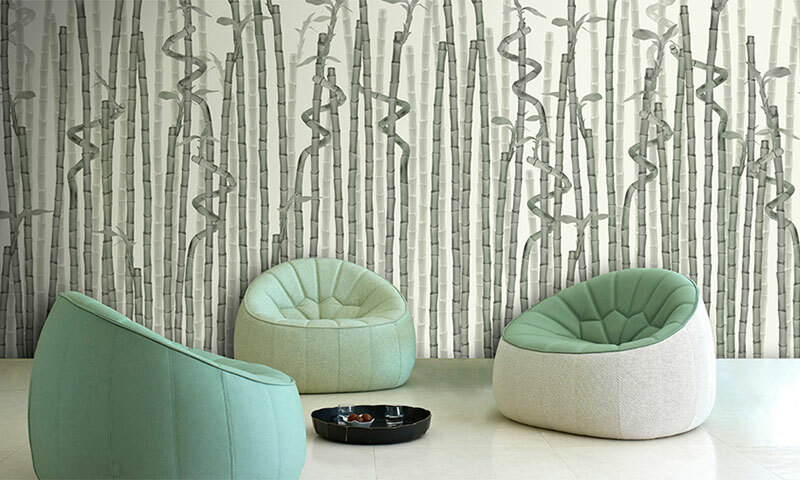
Valued for their incredible strength and durability, they are also much more expensive than vinyl ones. Here 70% is pressed paper and only 30% synthetic adhesive, which makes non-woven wallpaper relatively eco-friendly.
The standard width of such trellis is 1 m, many series allow for surface staining, which greatly extends the design possibilities of the premises. Also among the lines of nonwoven there are exclusive models painted by hand.
Recently appeared another interesting subspecies of such wallpapers - metallized trellises with the thinnest aluminum layer on the surface. The resulting coating looks just cosmic, while it has sufficient moisture resistance.
Pros:
- Good air permeability;
- Durability and fire resistance;
- Do not deform and do not tear in the process of gluing;
- Environmentally friendly;
- Possibility of staining in some models;
- Easy to paste and good adhesion to any substrate( concrete, drywall, wood, particle board);
- Without problems are removed from the wall.
Cons:
- Without a protective layer of vinyl or paint are unstable to moisture;
- Not cheap;
- Working with meter rolls is inconvenient.
Stained glass under painting
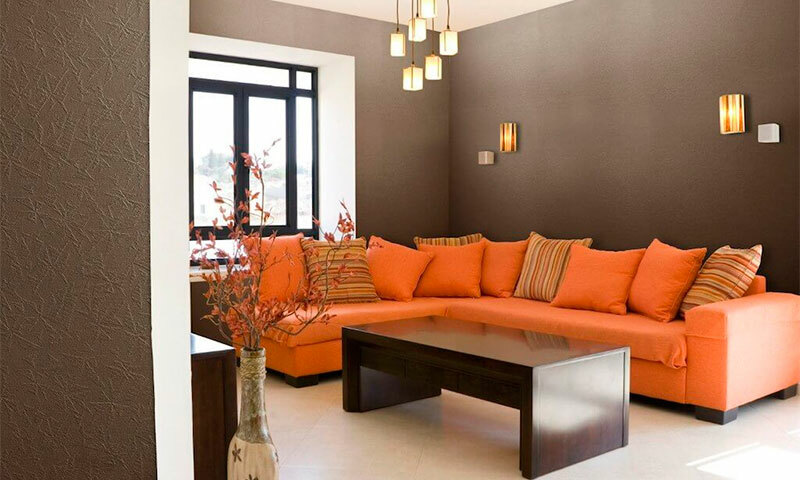
Represents single-color snow-white trellises( smooth or corrugated) on paper, vinyl or non-woven basis. Adding reinforcing fiberglass in their composition gives them a special strength and resistance to abrasion.
This wall covering can be repainted up to 5 times, washed and even brushed. This is an excellent solution for creating an original design interior, when it is very difficult to choose the right shade of walls or you want to add some zest.
Pros:
- Resistant to mechanical damage;
- Non-flammable and non-toxic;
- Hypoallergenic and "breathing";
- Allow multiple repainting;
- Strengthen the surface of the walls, preventing cracking of the plaster.
Cons:
- Deprived of expressive decorative elements;
- When pruning, give abrasive dust, as from glass wool.
Textile

Chic fabric trellis is made on paper or non-woven base. On the basis with the glue still on the production process, small fibers of silk, velor, felt or flax are sprayed. The result is an eco-friendly and luxurious decor for the walls.
Pros:
- Excellent breathability;
- Do not contain toxic and harmful substances;
- Keep shape after the label;
- Can be opened with varnish or painted;
- Do not require special sticking skills;
- Easily removed from the walls.
Cons:
- Very expensive;
- Accumulate dust and do not tolerate wet cleaning;
- Textile spraying is easy to damage.
Eco-wallpaper
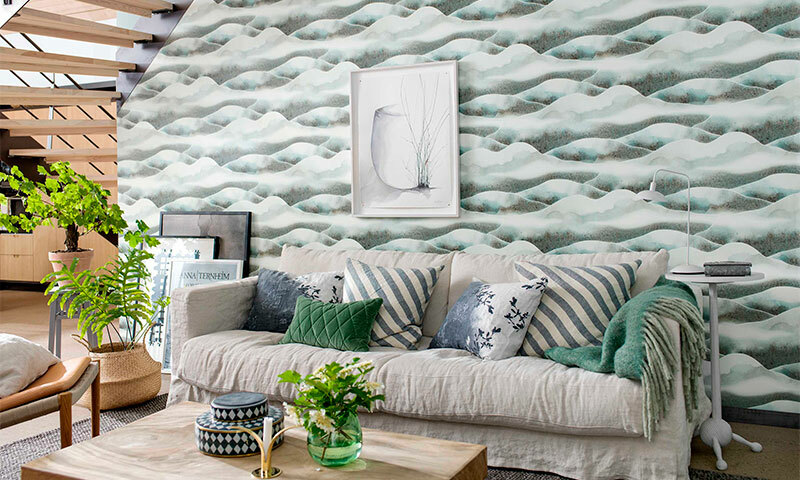
Producers of Asia supply the Russian market with exotic for our country natural wallpaper of rice, cane, bamboo, herbs and algae on paper or non-woven basis. They give the dwelling a unique color, absolutely safe for health and even have healing properties. However, deciding to decorate your house with such a curiosity, you will have to fork out.
Pros:
- Made of natural and environmentally friendly materials;
- Have a good heat and sound insulation;
- Fully conceal wall defects;
- The room is transformed beyond recognition;
- Some have bactericidal properties.
Cons:
- Visible joints between the canvas;
- When padding requires experience and patience;
- Heavy;
- May require additional varnish coating.
Wallpaper selection parameters
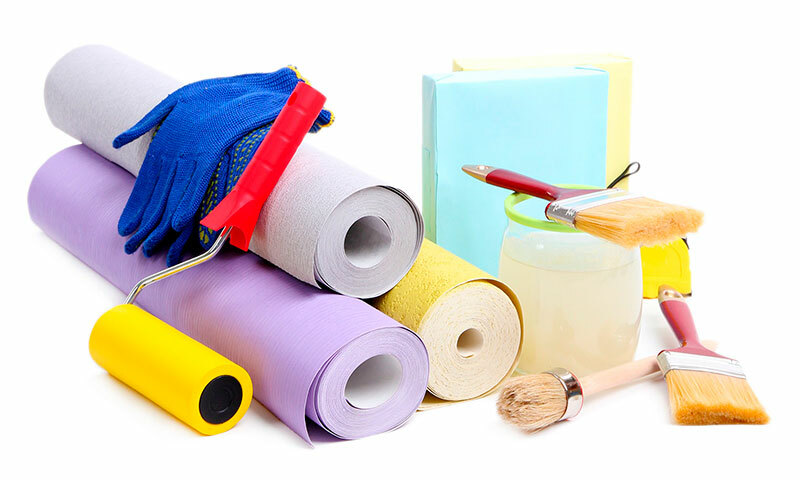
Resistance to external influences
The wallpaper resistance is usually defined as being immune to wet cleaning, sunlight and abrasion. The first criterion is especially important for the kitchen, bathroom, nursery or any other room in which the finish is exposed to wet steam or simply requires frequent washing. Waterproof coating also protects the walls from dampness, which means - from the appearance of fungus and mold.
Here you can select 3 levels of wallpaper resistance( on the label in the roll they are denoted by the corresponding number of long wavy lines):
1. Waterproof can be wiped with a damp cloth, but without fanaticism;
2. Washable - allow cleaning with a soft brush with non-corrosive chemicals;
3. Supersmers - carry even intense cleaning.
Lightfastness is taken into account when choosing wallpaper in a room with windows facing the sunny side. If you do not plan to hide from the bright rays behind the dense blinds, pay attention to the corresponding pictograms on the roll.
The level of color fastness of the trellis to UV rays without loss of color brightness is indicated by the image in the form of a sun:
- Half - satisfactory light fastness;
- The whole sun is good;
- With a plus sign inside - very good;
- 2 of the sun - excellent.
About buying wear-resistant wallpaper in the first place should think about young parents and pet owners. Special vandalism trellis worthy of the transfer of familiarity with the naughty baby, as well as claws, fangs and beaks of pets.
These properties have only a wall covering of fiberglass - no wonder manufacturers guarantee 30-year service of their products. You can find the anti-vandal wallpaper from the image of the hammer on the pictograph.
Relief
Relief wallpaper, unlike smooth, will help to hide small irregularities and wall defects, therefore, do not require pre-fill main surface. Embossing can be applied to any base substrate: paper, vinyl, nonwoven - cold or hot.
Manufacturers offer a variety of models of this kind of trellis, including super-realistic coatings with 3D images or simply imitating finishing materials( brickwork, wood, etc.).
The special symbol in the form of a creeping worm on the label will indicate the relief pattern. But remember that wallpaper with a convex pattern will accumulate dust, so that they will also require resistance to cleaning.
Need to select a drawing
An important point for those who are constrained in the means and can not afford to buy an extra roll of stock. About 50% of all wallpapers produced in the world are monophonic or have an indistinct pattern. Such products can be glued freely without fitting, reducing the amount of waste.
When gluing wallpaper with a large pattern consumes more material, so they should be taken with a margin. It may take up to 1 m of cutting for each strip, but if the pattern is repeated often enough, the waste will be less.
Roll width and length
The standard roll width is 53, 70 and 106 cm.
The second option is more often used by European manufacturers, ours are the first and the third.
Half-meter wallpaper is easier to paste small rooms or rooms with a lot of windows and doorways.
Metro coatings are more suitable for spacious apartments with solid walls, as well as for ceilings, where it is necessary to minimize the number of joints.
Non-woven fleece cloths are produced exactly in meter format, and paper because of their low density only in half a meter.
The length of the trellis on the roll is also regulated:
- 10 m - the most common size;
- 15 m - the standard for vinyl;
- 25 m - more often used in the manufacture of nonwoven products and wallpaper for painting.
Multiplying the width by the length, you get an area that can be pasted with one roll( adjusted for fitting the picture).After that it will be easier to determine the number of wallpapers for each room.
Which wallpapers to choose for different rooms
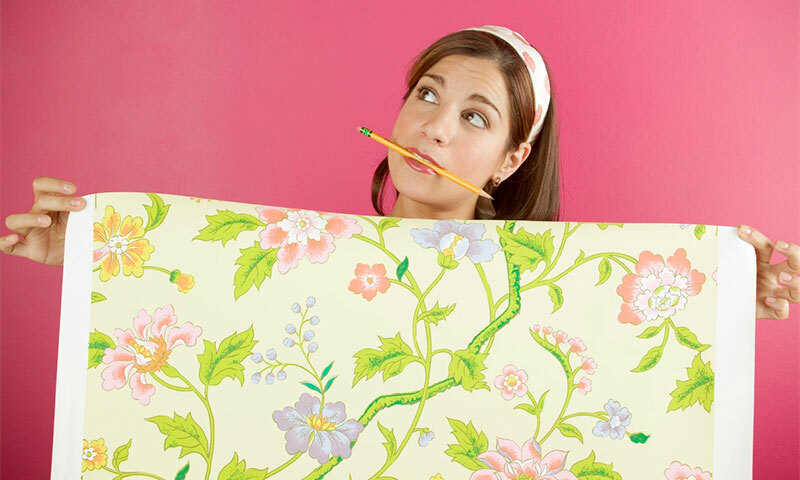
First, you need to remember a few rules for choosing wallpaper colors depending on the location and dimensions of the room:
- Visually, the light color tones with a rare and fine print help visually enlarge the small room.
- The vertical strip "lifts" the ceiling, and the horizontal strip expands the room visually.
- Dark colors and a large pattern will reduce and make an overly spacious room more cozy.
If the windows of your room look on the sunny side - choose wallpaper cold colors( green, blue, gray, purple), warm colors with yellow and red podonom "warm" the room, oriented to the North or West.
Now you can go directly to the choice of finishes for each corner of the apartment.
In the hallway
This nedomkomota sees street dirt and dust more than others. At the same time, she meets guests and hosts, as soon as they cross the threshold of the house. Accordingly, the decorative finish of the hallway should be beautiful, create a feeling of comfort and well suited to cleaning.
It is best to cope with the task of smooth vinyl or glass pavement for painting. Just choose an unremarkable fine pattern and discard monophonic patterns to prevent accidental stains and damage from catching your eye.
For the kitchen and bathroom
Here the wallpaper has to withstand constant humidity and temperature changes. In addition, even a powerful kitchen hood does not guarantee 100% protection of the walls from fat and paraffin soot, which means that you will often wash them.
The main requirement for a wall covering in such conditions is the lethal moisture resistance and resistance to abrasive loads. These criteria are fully met by smooth superma and compact vinyl, as well as fiberglass for painting on PVC-based. However, individual inserts of bamboo will also quietly survive the neighborhood with water and hot steam.
In the living room
Here, the wallpaper should "make an impression": ideally fit into the interior and have a spectacular appearance.
In the living room you can paste any trellis, but it will look especially well:
- embossed paper duplex;
- foamed vinyl;
- silk screen printing;
- elite fleece;
- fabric models.
A special charm of the apartments will be provided with metalized coverings, if you prefer the style of high-tech, or expensive eco-wallpapers of natural materials.
In the bedroom
In this room you should not choose the finishing of bright colors, otherwise you can not normally relax and rest. Another important criterion for choosing wallpaper for the bedroom is their ecological compatibility and air permeability - this will help create a healthy microclimate in the room.
The task will cope with paper coatings, fleece on a cellulose base and cozy textiles. If the budget allows, decorate the bedroom with unusual eco-wallpapers from sisal, algae or jute.
In the nursery
Finishing materials are selected here with great care. The main requirement for children's wallpaper: safety and pretty, but not flashy coloring. Remember that a small tenant can not only paint and tear trellises, but also taste them. Therefore, when buying, pay attention to the manufacturer: it is better to overpay for a proven brand than to take a "cat in a poke".
If the child is still very small, it makes no sense to buy expensive wallpaper, then to scold a child for a wall painting or a peeled relief pattern. Simply glue beautiful and eco-friendly paper wallpaper, which without much damage to the family wallet can be changed at least every year. But the schoolchildren are well suited for vinyl or non-woven - they are well-plastered steep posters.
How much are wallpapers

1. The thinnest paper simplex wallpaper can be bought from 100 rubles.for a roll, prices for duplex and triplex start from 250. Products of European brands are sold from 500 rubles.per roll. Baby can be bought for 300-400 rubles and above.
2. Vinyl wallpaper will not be cheaper than 300-500 rubles, if you choose a domestic manufacturer, and from 600 to 10 thousand rubles.for the overseas brand. For serigraphy, you will have to lay out at least 1000.
3. Non-woven fleece trellis on paper basis will cost about 3500-5000 rubles, clean fleece can be found for 300, and for 30,000 - it all depends on the manufacturer.
4. Each roll of wallpaper will reduce your budget by 1000 rubles.
5. The run-up of prices for textile fabrics ranges from 1 to 20 thousand rubles, depending on the type of coverage and brand promotion.
6. Prices for eco-wallpapers are directly dependent on the material of their manufacture. Roll jute costs 4500-7500 rubles, a product of grass is not less than 2500, the finishing of the leaves will pull by 6-12 thousand, and for a square meter of bamboo have to give at least 750 rubles.



